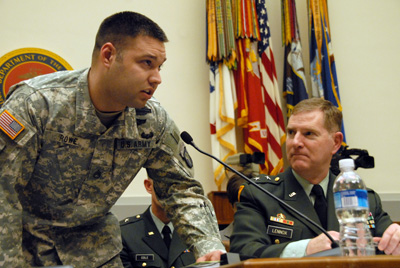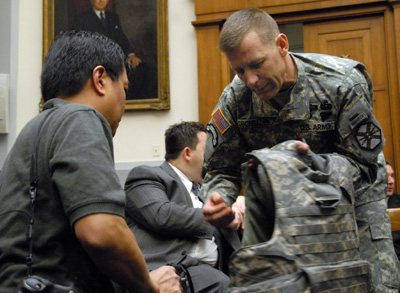By C. Todd Lopez
WASHINGTON (Feb. 05, 2009) -- During testimony on Capitol Hill regarding force protection programs, Feb. 4, an Army staff sergeant had the opportunity to let members of Congress know about some of the challenges faced by Soldiers in Iraq.
Staff Sgt. Fred Rowe of the 101st Airborne Division (Air Assault) testified before the House Armed Services Committee's joint session of the air and land forces subcommittee and the seapower and expeditionary forces subcommittee. Rowe is currently assigned to the 3-187th Infantry at Fort Campbell, Ky.

Rowe told Congressmen that in Iraq, he was saved by the body armor he wears, and said that he and the Soldiers he knows feel confident their protective gear is capable of protecting them.
"I took three rounds to the chest -- with body armor," Rowe said. "All three rounds were stopped by the plates. It hurt, but I was still mission capable. I was still able to do my job. And once I got my breath back, I was breathing fine and I was thanking the good Lord above that everything was all right."
Rowe said he knows the ballistic plates in his protective gear are designed to hold up to a volley of three shots -- and the gear he wore met that standard.
"Some of the times when a bullet hits, it ricochets off, and sometimes they imprint and mushroom up. Supposedly it holds up for three shots -- it did for me. But if you get hit once, you replace it," he said.
Rowe also told Congressmen that the body armor he wore in Iraq was sometimes too heavy and bulky for the specific mission he was performing.
"It comes to a point where you are more mission incapable of doing our job or you're more at risk or vulnerable with all the equipment on," Rowe said of the body armor. "There's times I've been on a mission where I could have gotten out of the firefight a lot quicker and I could have handled business a lot easier if I was able to be more mobile or be more effective with less weight."
While the Army leaves it up to commanders to decide what protective gear is required for their Soldiers, Rowe told lawmakers it would be best if those closest to a particular mission could make the call.
"I think it should be left up to the commanders or to the independent leaders on the ground to decide what kind of armor we need to take out -- or if we can downgrade," he said.
Rowe, who's served as both an infantryman and a sniper during his two deployments to Iraq, said that sometimes Soldiers are tempted to take off pieces of body armor -- at increased risk to themselves -- to make themselves more mobile and agile.

"There's a risk all Soldiers are willing to take," he said. "I think that (in) certain situations -- mission dependant -- as Soldiers we would be happy to take off some of the body armor to be more mission capable, more mobile on the ground, more flexible, faster."
Army leaders say the weight of protective gear worn by both Soldiers and Marines is heavy on their minds, and they are working to find solutions to the problem.
"It is this tradeoff between effectiveness and weight," said Maj. Gen. Robert P. Lennox, assistant deputy chief of staff, G-3/5/7. "How are we going to be able to have lighter capabilities that still allow our Soldiers to do our mission -- we struggle with that and struggle with that in some of the decisions."
The general told lawmakers he was willing to further discuss the kinds of decisions the Army faces in a closed session.
Marine Corps Brig. Gen. Michael Brogan, Marine Corps Systems Command, program executive officer, MRAP Joint Program Office, told lawmakers he has asked manufacturers to look into developing lighter protective gear for Marines and Soldiers.
"This is an area where we need some additional science and technology research conducted," he said. "I have implored (manufacturers) to develop the materials that will allow us to go from hard ceramic plates -- to something that may involve carbon tubes or nano-technology that can significantly reduce the weight. Currently that technology does not exist. There is limited work being done in government laboratories, but today we do not have that technological breakthrough we need to significantly lighten the load."
Recently, Secretary of the Army Pete Geren made the decision to identify and collect 16,413 sets of Enhanced Small Arms Protective Insert plates. The inserts are being collected in response to a dispute between the Army, the Department of Defense Inspector General and the Director of Operational Test and Evaluation over adherence to testing standards on the plates.
The Defense IG questioned testing procedures for three of the eight ballistic inserts that passed "first article tests" by the Army. However, the director of Operational Test and Evaluation, who independently assessed and verified the results, determined that the plates passed the tests.
Brig. Gen. Peter N. Fuller, the commanding general of the Soldier Systems Center, Program Executive Office Soldier, told lawmakers the Army is working to correct issues that would have led to disputes over testing procedures, but that the plates issued to Soldiers are in fact safe.
"We never issued defective body armor," Fuller said. "We might have had process issues. We've cleaned up these process issues, and we are moving forward to continue to straighten this out -- but Soldiers have the best body armor by far."